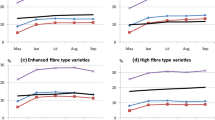Abstract
Fiber flax varieties should be well adapted to the climatic conditions of the region and resistant to lodging, diseases, and other stress factors. The results of studying the collection varieties of fiber flax of different ecological and geographical origin in the soil and climatic conditions of Kirov oblast (Falenki Breeding Station, branch of the FASC of the Northeast) are presented. The collection is represented by varieties from Russia (44%), Belarus (13%), France (9%), China (8%), Lithuania (7%), Canada (4%), Ukraine (3%), the Netherlands (3%), and other countries. The aim of the research was to evaluate the genetic sources of fiber flax according to the main economically valuable traits and to select the best ones for further breeding. The meteorological conditions during the years of research (2000–2018) differed significantly in the amount of precipitation, the sum of temperatures, and in the nature of their distribution throughout the growing season. It was possible to assess the genetic potential of collection varieties in terms of productivity and resistance to unfavorable environmental factors and to identify sources for use in breeding. The maximum straw yield was 70–182 g/m2 higher compared with the yield of the standard (the Tvertsa variety). It was obtained in 2009 from the Soglasie, Start, Stroitel, and Dashkovsky 2 (Belarus) varieties. Peresvet, Nord, Dobrynya (Pskov Research Institute of Agriculture) varieties significantly exceeded the standard in fiber content (by 4.7–10.1%). Yubileiny 87, Alexandrite, Mirazh, AR4, AR5, AR6 (ASRI of flax); TOST 3, TOST 4 (Siberian Research Institute of Agriculture and Peat); Dashkovsky 2, Signal, Start, Iva, Vasilek, Praleska, Yarok (Belarus); Rushnichok (Ukraine); Agatha (Netherlands); Drakkar (France); Flax of Heilonjiang no. 10; and Yuan 2003-43 (China) stood out in terms of a set of economically valuable features.
Similar content being viewed by others
REFERENCES
Golub, I.A., Len Belarusi: Monografiya (Flax of Belarus: Monograph), Minsk: ChUP Orekh, 2003.
Voronov, S.I., Medvedev, A.M., Osipov, V.V., Osipova, A.V., Zhikharev, S.D., Liseenko, E.N., and Poma, N.G., The selective-genetic value of winter triticale cultivar samples from the collection for cultural breeding in the Central Nonblack Earth Region, Russ. Agric. Sci., 2019, vol. 45, pp. 105–111.
Jankauskiene, Z. and Bacelis, K., Evaluation of long fibre quality of fiber flax cultivars and breeding lines by different methods, Agriculture, 2008, vol. 95, no. 1, pp. 93–106.
Bacelis, K. and Jankaskiene, Z., Investigation and use of the Lithuanian flax genetic resources in the breeding programs, Environment. Technologies. Resources. Proceedings of the International Scientific and Practical Conference, 2005, pp. 85–92.
Shchennikova, I.N., Effect of weather conditions on the growth and development of barley plants in Kirov oblast, Agrar. Nauka Evro-Sev.-Vostoka, 2014, no. 4, pp. 9–13.
Koshcheeva, N.S., Lyskova, I.V., Batalova, G.A., and Kraeva, S.N., Initial material for breeding of fiber flax under conditions of the Volga-Vyatka region, Russ. Agric. Sci., 2017, vol. 43, no. 4, pp. 285–288.
Stafecka, I., Stramkale, V., and Grauda, D., Estimation of yield stability for flax genetic resource using regression and claster analysis, Res. Rural Dev., 2016, vol. 1, pp. 15–19.
Diederichsen, A., Rozhmina, T., Zhuchenko, A.J., et al., Screening for adaptation in flax (Linum usitatissimum L.) germoplasm accessions based on field trials in Canada and Russia, Plant Genet. Resour. Newslett., 2006, no. 146, pp. 9–16.
Korpunin, B.F. and Ushchapovskii, I.V., Adaptive reactions of fiber flax to changes in climatic conditions during the growing season, Zemledenie, 2015, no. 6, pp. 36–39.
Metodicheskie ukazaniya po selektsii l’na-dolguntsa (Guidelines for Fiber Flax Breeding), Moscow, 2004.
Metodicheskie ukazaniya po provedeniyu polevykh opytov so l’nom-dolguntsom (Methodical Instructions for Conducting Field Experiments with Fiber Flax), Torzhok, 1978.
Metodiki tekhnologicheskoi otsenki produktsii l’na i konopli (Techniques for Technological Assessment of Flax and Hemp Products), Moscow, 1961.
Agroklimaticheskie resursy Kirovskoi oblasti (Agroclimatic Resources of Kirov Oblast), Leningrad: Gidrometizdat, 1974.
Doronin, S.V. and Tikhvinskii, S.F., Len-dolgunets. Tekhnologiya vozdelyvaniya i selektsiya (Fiber Flax. Cultivation Technology and Breeding), Kirov: VGSKhA, 2003.
Pavlova, L.N., Gerasimova, E.G., and Rumyantseva, V.N., The current state, directions, and prospects for the development of fiber flax breeding at VNIIL, in Len – strategicheskaya kul’tura XXI veka (Sostoyanie, problemy i perspektivy razvitiya APK) (Flax: Strategic Culture of the 21st Century (State, Problems, and Prospects for Development of the Agro-Industrial Complex)), Pskov: Pskov. NIISKh, 2015, pp. 15–19.
Author information
Authors and Affiliations
Corresponding authors
Ethics declarations
The authors declare that they have no conflict of interest. This article does not contain any studies involving animals or human participants performed by any of the authors.
Additional information
Translated by M. Shulskaya
About this article
Cite this article
Koshcheeva, N.S., Batalova, G.A., Lyskova, I.V. et al. Evaluation of the Modern Gene Pool of Long-Fiber Flax on the Main Economies and Valuable Characteristics in the Conditions of Kirov Oblast. Russ. Agricult. Sci. 46, 437–441 (2020). https://doi.org/10.3103/S1068367420050109
Received:
Accepted:
Published:
Issue Date:
DOI: https://doi.org/10.3103/S1068367420050109



